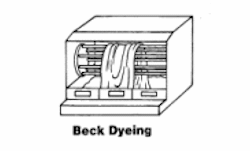|
beck
dyeing carpet
Beck Dyeing Carpet

Beck dyeing is an excellent technique for
dyeing carpet pieces or rolls. The carpet is placed in a large vat
filled with dyes, chemicals, and water. It turns constantly on a reel
inside the beck - at an ideal rate of one revolution per minute - so
that dye may be applied evenly. The liquids in the beck are heated to
200 degrees F., which is maintained until the dye cycle ends (about 30
minutes).
This is a flexible method, because a number of different colors may be produced using
the same carpet fabric base (i.e., separate batches of a single base fabric are placed in
various dye becks, each with a different color dye). Different roll
sizes may also be accommodated, from 50'to 500', and a jumbo beck can
dye two 500' rolls at once.
Dye Lab
A successful beck dyeing operation
begins in the dye lab, where a formula or dye recipe is created for each
color before carpet goes into the becks. To make solid colors, formulas
are created usin@z acid dves in red, yellow, and blue, the
combination of which can produce any color possible.
Once the correct color is achieved in the lab, the same formula is used to dye a roll
of carpet in a beck. The formula is simply scaled up and adapted to the weight of the roll
to be dyed.
The Role of PH
PH plays an important role in beck
dyeing and should be monitored throughout the dye cycle. It controls
strike rate, or how fast the dye is absorbed, and dye exhaustion, the
total amount of dye that goes into the fiber. Uneven color or spots can
occur if dye absorption (strike rate) is too rapid or if too little dye
is absorbed (90 percent exhaustion is ideal).
The key to having a good strike rate and accurate exhaustion is to start the dye cycle at a
high pH, so the strike rate is slow and the dye will be absorbed evenly by the fiber.
(On light to medium colors, the ideal starting pH is 8.0.)
Near the end of the dye cycle, the pH should be dropped to 6.0 or lower to increase the dye
exhaustion. With dark colors that need large amounts of dye, the pH should be lowered to
5.5 or less, yielding a greater increase in dye exhaustion and more
even color. This measure also means less dye is used, which promotes
efficiency and cost control.
PH works a bit differently on bi-dye
products (styles that contain more than one color and have an accent pin
dot). Solid shades are dyed primarily with acid dyes, while bi-dye
products utilize acid and cationic dyes. The acid dyes will dye the base
or background color, while the cationic dyes will dye the accent pin
dots.
As lower pH's exhaust the acid dyes, cationic dyes exhaust more rapidly with a higher pH.
Therefore, we try to keep the pH in the mid-range (about 6.5) throughout the complete dye
cycle, so that the percentage of exhaustion for both types of dyes is about equal.
See Also:
continuous dyeing |
skein dyeing|
space
dyeing |
solution
dyeing
©2010 FloorBiz, Inc. All Rights Reserved
Flooring |
Flooring Guide |
Flooring Info |
Flooring Forum
| |
